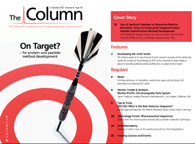Blood life
Conditions of acute and chronic anaemia that are the result of either a long-standing medical condition (sickle-cell anaemia) or surgical intervention (chemotherapy) often require the administration of blood transfusions to improve the capacity of the patient's red blood cells to carry oxygen1. Red blood cell (RBC) populations have a short shelf life in storage as a result of biomechanical and biochemical changes that reduce the RBC functionality. This has an impact on the viability and therapeutic benefits of ex vivo RBC transfusions.
Conditions of acute and chronic anaemia that are the result of either a long-standing medical condition (sickle-cell anaemia) or surgical intervention (chemotherapy) often require the administration of blood transfusions to improve the capacity of the patient’s red blood cells to carry oxygen1. Red blood cell (RBC) populations have a short shelf life in storage as a result of biomechanical and biochemical changes that reduce the RBC functionality. This has an impact on the viability and therapeutic benefits of ex vivo RBC transfusions.
A group of investigators in Germany2 has identified a potential solution to this problem, identifying three so-called ‘biomarkers’ that could be used in the development of an assay determining the effect of storage on the functionality of RBC’s. Biomarkers are candidate proteins that can be identified with relative ease and efficiency, have specific physiological functions and specific localisation within a cell. Despite the simple structure and high availability of RBC’s, the high concentration of membrane proteins and intracellular haemoglobin present a complex analytical mixture.
The investigators observed changes in the RBC proteome over a time course of 42 days. 2D DIGE (2-D Fluorescence Difference Gel Electrophoresis) was used to quantitively measure changes in cytosolic proteins over the time course, providing a so-called ‘spot map’, where specific protein spots could be visualised to change over time. Selected protein spots were isolated by trypsin digestion, identified by liquid chromatography– mass spectrometry (LC–MS) and validated by western blotting (the detection of proteins within a gel with a specific antibody). Out of fourteen protein spots identified to be altered post storage, three proteins were selected as potential biomarkers for the monitoring of RBC ageing: transglutaminase 2, ß-actin and copper chaperone for superoxide dismutase.
The discovery of a change in the cytosolic proteome profile and the identification of potential biomarkers is an important step towards improving our understanding of blood storage methods. It may go some way to contributing to the development of specific assays for the measurement and therefore judgement of the therapeutic benefits of blood transfusions to critically ill patients.
1. UK Blood Transfusion & Tissue Transplantation Services: Transfusion Handbook. (www.transfusionguidelines.org.uk)
2. K. Walpurgis et al, Proteomics Journal (2012) DOI: 10.1002/pmic.201200280.
This story originally appeared in The Column. Click here to view that issue.

HPLC 2025 Preview: Fundamentally Speaking (Part 2)
May 14th 2025Michael Lämmerhofer from the Institute of Pharmaceutical Sciences, University of Tübingen, Germany, spoke to JFK Huber Lecture Award winner of 2024 Torgny Fornstedt, professor in analytical chemistry and leader of the Fundamental Separation Science Group, Karlstad University, Sweden, about his pioneering work in high performance liquid chromatography (HPLC) with a focus on fundamentals, ion-pair chromatography, and oligonucleotide applications.

.png&w=3840&q=75)

.png&w=3840&q=75)



.png&w=3840&q=75)



.png&w=3840&q=75)








